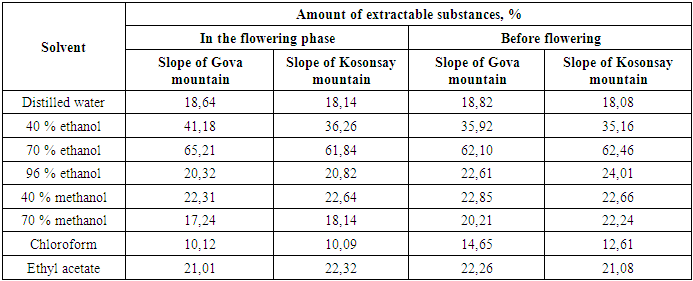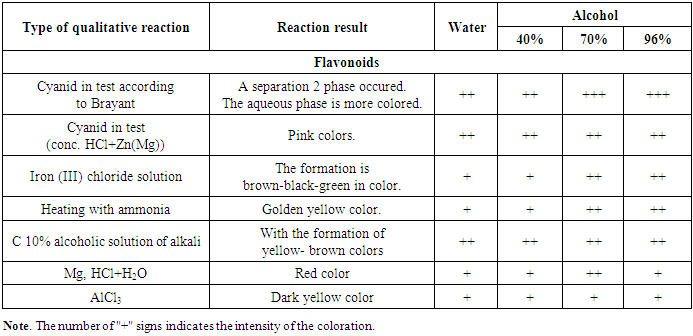-
Paper Information
- Paper Submission
-
Journal Information
- About This Journal
- Editorial Board
- Current Issue
- Archive
- Author Guidelines
- Contact Us
International Journal of Materials and Chemistry
p-ISSN: 2166-5346 e-ISSN: 2166-5354
2024; 14(6): 97-102
doi:10.5923/j.ijmc.20241406.01
Received: Nov. 18, 2024; Accepted: Dec. 8, 2024; Published: Dec. 16, 2024

Study of Nepeta Olgai Regel L. Phenol Compounds by HPLC Method
R. S. Dekhkonov, M. Yu. Mamadjonova, Sh. V. Abdullayev
Namangan State University, Namangan, Uzbekistan
Copyright © 2024 The Author(s). Published by Scientific & Academic Publishing.
This work is licensed under the Creative Commons Attribution International License (CC BY).
http://creativecommons.org/licenses/by/4.0/

In this study, flavonoids of the plant Nepeta Olgae Regel, belonging to the Laminaceae family, collected in Chust (mountain slopes of Gowa) and Kosonsoy (mountain slopes and hills) were studied. In the process of studying the qualitative and quantitative flavonoid composition of Nepeta Olgae Regel L. plants, thin-layer (TLC) and high-performance liquid chromatography (HPLC) were used to identify 6 compounds that were assigned to this class of compounds. Among them, the most predominant were rutin, salidroside, dihydroquercitin and quersitin.
Keywords: Extractive substances, Flavonoids, Nepeta Olgae Regel L., High performance liquid chromatography, Qualitative and quantitative analysis
Cite this paper: R. S. Dekhkonov, M. Yu. Mamadjonova, Sh. V. Abdullayev, Study of Nepeta Olgai Regel L. Phenol Compounds by HPLC Method, International Journal of Materials and Chemistry, Vol. 14 No. 6, 2024, pp. 97-102. doi: 10.5923/j.ijmc.20241406.01.
Article Outline
1. Introduction
- One of the priority directions in the search for new biologically active substances is the study of wild plant species of Uzbekistan, whose resources are quite abundant [1-3]. This approach ensures a reliable long-term raw material base, allows for the rational use of these plant resources, and provides the opportunity to expand the range of medicinal plant raw materials and medicines based on them.From this perspective, plants of the Lamiaceae family are of particular interest. The Lamiaceae family includes about 200 genera and 3500 species, and is found almost worldwide. These are perennial herbaceous plants, many of which are medicinal, aromatic, essential oil-bearing, and ornamental, and are of great significance [2-4].In connection with this, many species of plants belonging to the Lamiaceae family (Lamiaceae) have long been included in the medicinal plant raw material arsenal of foreign countries. In Uzbekistan, there are many species and reserves of such medicinal plants [1-3].One such promising and poorly studied plant is Nepeta Olgae Regel L., a species belonging to the Lamiaceae family, which is found in the flora of the Namangan region [1-2].
2. Objective of the Study
- The aim of the study is to investigate the flavonoids of the plant Nepeta Olgae Regel (L.) found in Uzbekistan’s Namangan region.
3. Materials and Methods
- The aerial parts of the plant were collected and air-dried in the laboratory for two weeks and then ground into a fine powder using a sterilized mechanical grinder. After this, the qualitative parameters (moisture content, ash content, and extractive substances) were studied [5-6]. The results are presented in Tables 1 and 2.Widely used methods in the literature for the separation of extractive substances include the use of different solvents according to their polarity, to separate substances into fractions with similar polarity (chloroform, ethyl acetate, and n-butanol). These fractions were extracted sequentially with these solvents and used for further research. The extraction scheme of flavonoids from Nepeta Olgae Regel L. is shown in Figure 1.Flavonoids in the extractive substances were determined by liquid chromatography. 5-10 g of the sample were weighed and placed in a 300 ml flat flask. 50 ml of 70% ethanol solution was added. The mixture was heated to 70–80°C while stirring for 1 hour and then mixed at room temperature for 2 hours. The mixture was then cooled and filtered. The remaining portion was extracted twice with 25 ml of 70% ethanol. The filtrates were combined and brought to the mark with 70% ethanol in a 100 ml volumetric flask. The resulting solution was centrifuged at 6000–8000 rpm for 20–30 minutes. The solution was taken from the upper part for analysis.Flavonoids in chloroform, ethyl acetate, butanol, and aqueous fractions isolated from the aerial parts of Nepeta Olgae Regel L. were determined by high-performance liquid chromatography (HPLC). The results obtained are presented in Table 3 and Figures 1–2.In the literature, phosphate, acetate buffer systems, and acetonitrile are used as eluents for determining steroids and flavonoids by HPLC. In this study, a phosphate buffer system and acetonitrile were used.The experiment was conducted on an Agilent-1200 HPLC system using an Agilent Eclipse XDB-C18 5 µm, 4.6x150 mm column. Elution was performed in isocratic mode. Phosphate buffer systems and acetonitrile were used as mobile phases. The flow rate was 1.0 ml/min, and the injection volume was 10 µl. The measurement was carried out at wavelengths of 320 nm, 254 nm, and 276 nm. The gradient was as follows: 1-6% B/min (0-2.5 min); 6-30% B/min (2.51-40 min); 30-60% B/min (40.1-45 min); 60-60% B/min (45.1-50 min); 60-0% B/min (50.1-55 min).Standard solutions of dihydroquercetin, quercetin, luteolin, rutin, sinaroside, and salidroside, prepared at a concentration of 10 µg/ml, were used for identification based on the literature data.The composition and quantity of the flavonoids obtained are presented in Figures 1–6 and Table 4.
4. Results and Discussion
- The qualitative parameters of Nepeta Olgae Regel L. were determined according to the requirements of the State Pharmacopoeia (GOST 22839, ГОСТ 24027.2) [5-6].
|
|
|
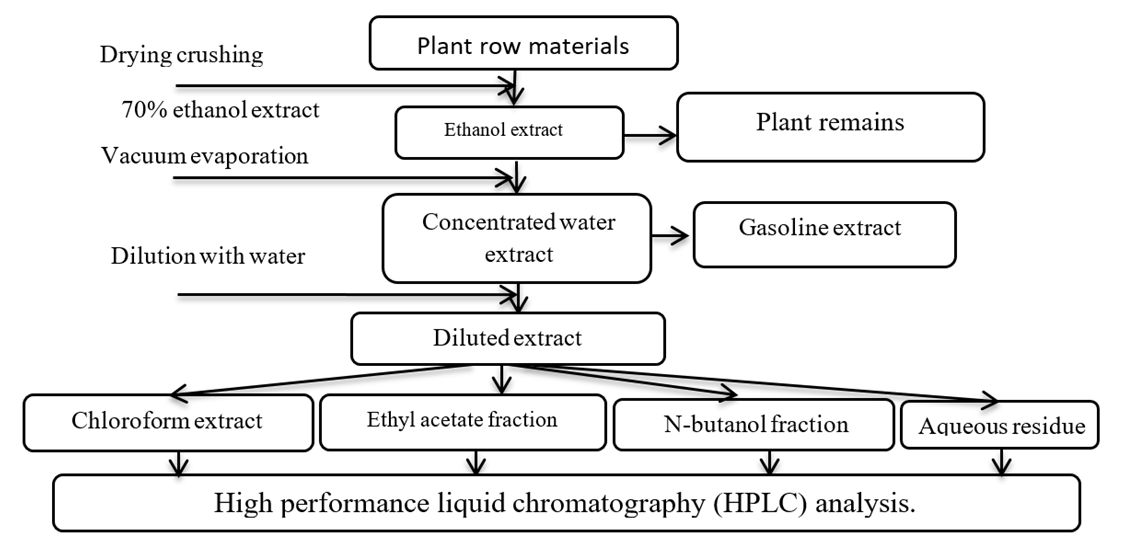 | Figure 1. Scheme of fractionation of plant extracts of Nepeta Olgae Regel L. based on their solubility in various solvents |
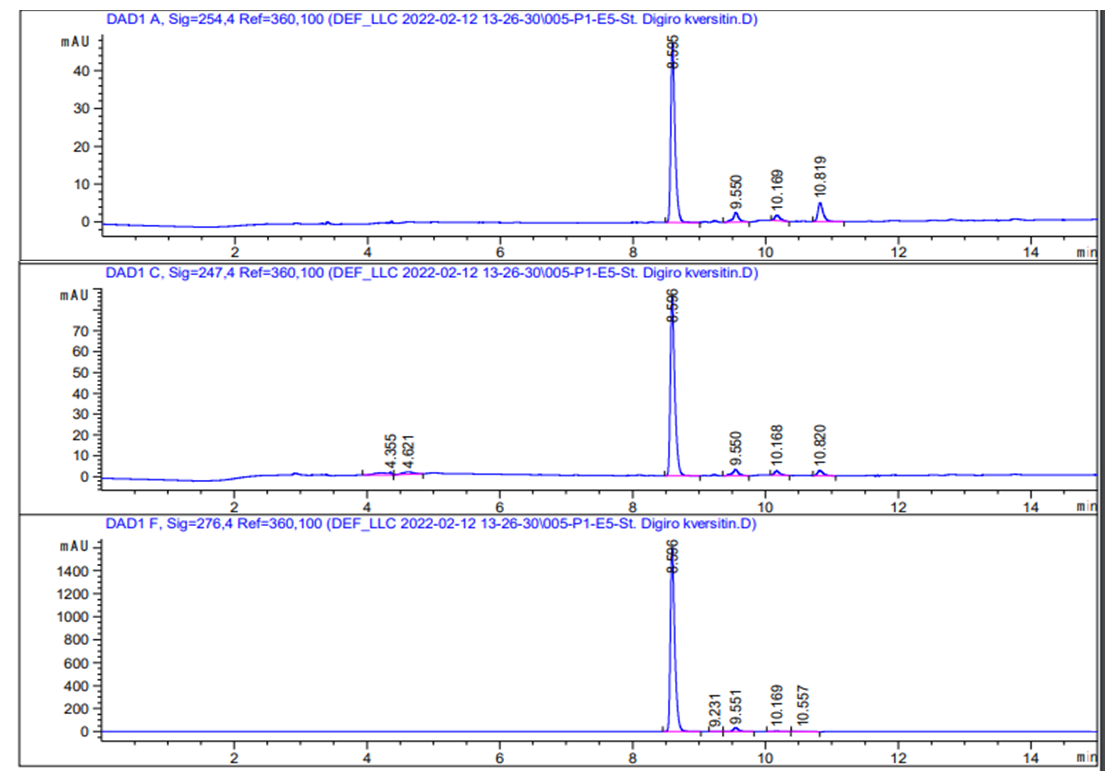 | Figure 2. HPLC analysis of the flavonoid dihydroquercetin |
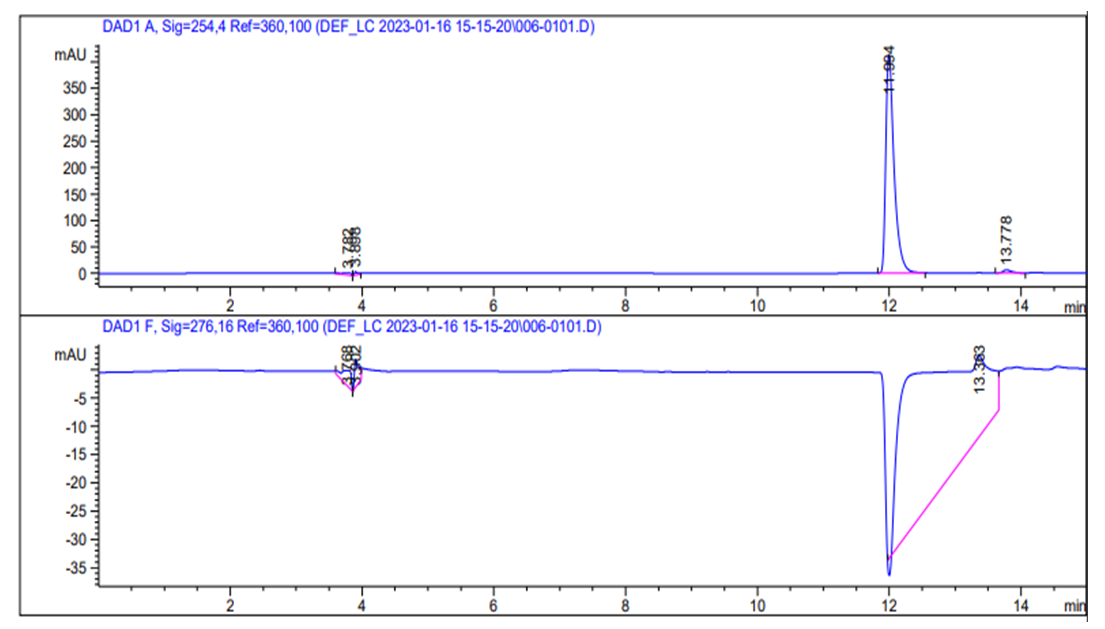 | Figure 3. HPLC analysis of the flavonoid Luteolin |
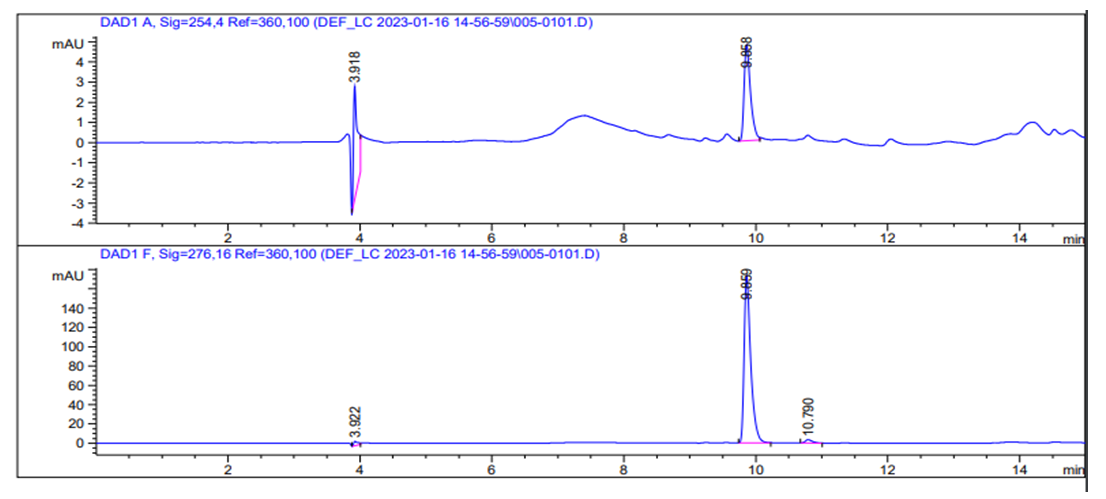 | Figure 4. HPLC analysis of the flavonoid Quercetin |
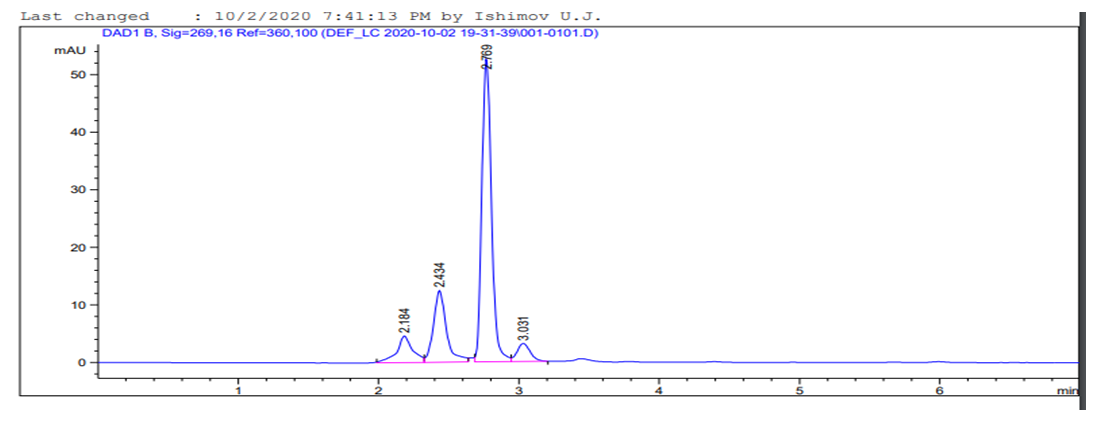 | Figure 5. HPLC analysis of the flavonoid Rutin |
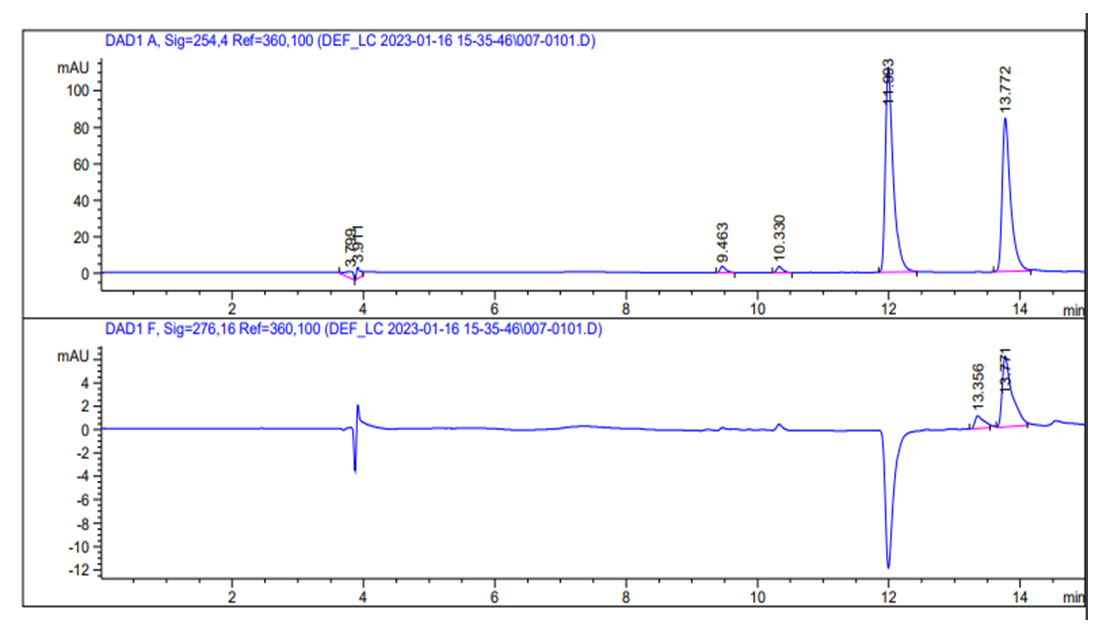 | Figure 6. HPLC analysis of the flavonoid Synerozide |
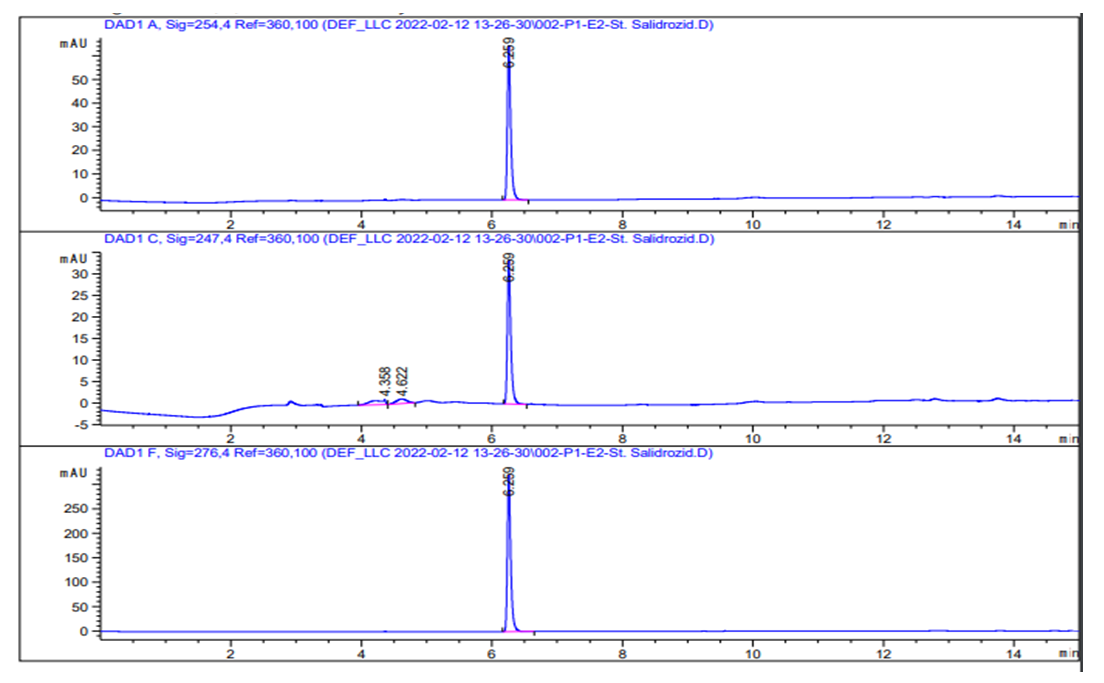 | Figure 7. HPLC analysis of the flavonoid Salidroside |
|
5. Conclusions
- Using high-performance liquid chromatography, the composition and quantity of flavonoids in the aerial part of Nepeta Olgae Regel L. were studied for the first time. The content of flavonoids dihydroquercetin, luteolin, quercetin, rutin, synerozide, and salidroside was determined.Thus, the raw material of the plant Nepeta Olgae Regel L. has high quality, and medicinal substances can be extracted from it.
 Abstract
Abstract Reference
Reference Full-Text PDF
Full-Text PDF Full-text HTML
Full-text HTML
